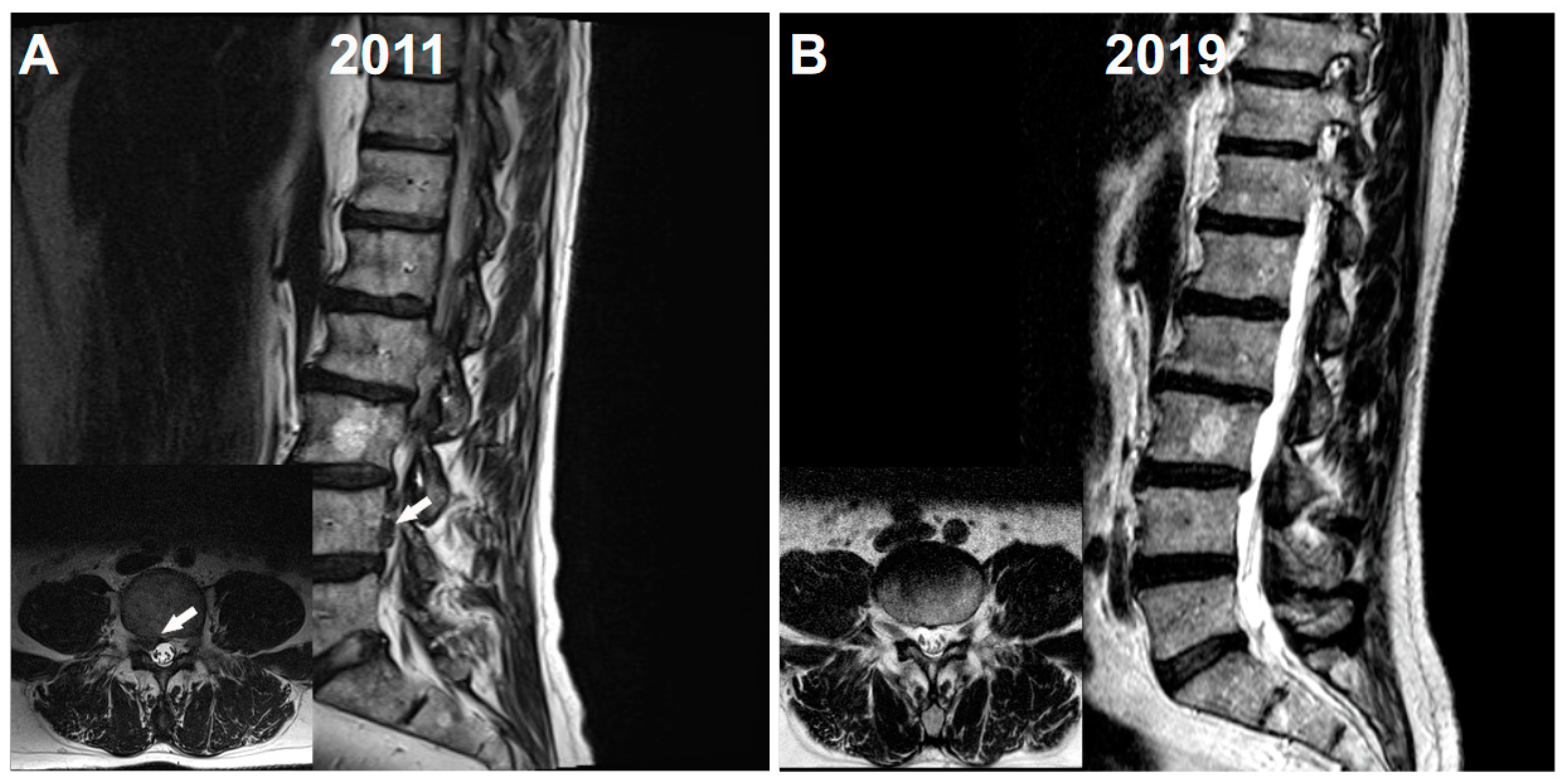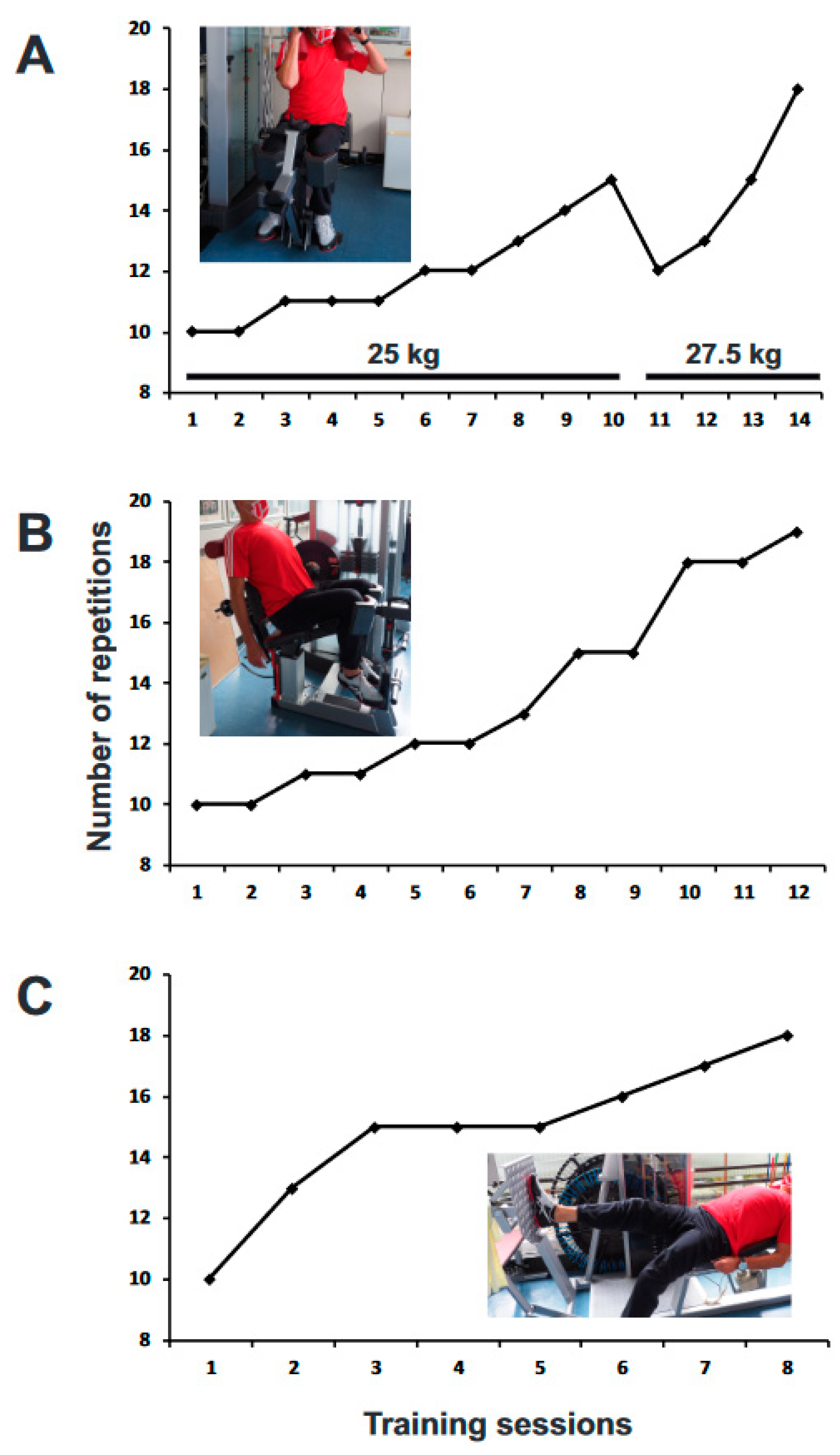Follow-Up of a Case of Dopamine-Mediated Yawning-Fatigue-Syndrome Responsive to Opioids, Successful Desensitization via Graded Activity Treatment
Abstract
1. Introduction
2. Case Presentation
3. Discussion
4. Conclusions
Author Contributions
Funding
Institutional Review Board Statement
Informed Consent Statement
Acknowledgments
Conflicts of Interest
References
- Dibaj, P.; Brockmann, K.; Gärtner, J. Dopamine-mediated Yawning-Fatigue-Syndrome, specific recurrent initiation and responsive to opioids. JAMA Neurol. 2019, 77, 254. [Google Scholar] [CrossRef] [PubMed]
- Argiolas, A.; Melis, M.R. The neuropharmacology of yawning. Eur. J. Pharmacol. 1998, 343, 1–16. [Google Scholar] [CrossRef]
- Collins, G.T.; Eguibar, J.R. Neurophamacology of yawning. Front. Neurol. Neurosci. 2010, 28, 90–106. [Google Scholar]
- Krestel, H.; Bassetti, C.L.; Walusinski, O. Yawning—Its anatomy, chemistry, role, and pathological considerations. Prog. Neurobiol. 2018, 161, 61–78. [Google Scholar] [CrossRef]
- Abrahams, H.J.G.; Gielissen, M.F.M.; Braamse, A.M.J.; Bleijenberg, G.; Buffart, L.M.; Knoop, H. Graded activity is an important component in cognitive behavioral therapy to reduce severe fatigue: Results of a pragmatic crossover trial in cancer survivors. Acta Oncol. 2019, 58, 1692–1698. [Google Scholar] [CrossRef]
- Bossen, D.; Veenhof, C.; Van Beek, K.E.; Spreeuwenberg, P.M.; Dekker, J.; De Bakker, D.H. Effectiveness of a web-based physical activity intervention in patients with knee and/or hip osteoarthritis: Randomized controlled trial. J. Med. Internet Res. 2013, 15, e257. [Google Scholar] [CrossRef]
- Borg, G.A. Psychophysical bases of perceived exertion. Med. Sci. Sports Exerc. 1982, 14, 377–381. [Google Scholar] [CrossRef]
- Gatzounis, R.; Schrooten, M.G.S.; Crombez, G.; Vlaeyen, J.W.S. Operant learning theory in pain and chronic pain rehabilitation. Curr. Pain Headache Rep. 2012, 16, 117–126. [Google Scholar] [CrossRef]
- Marin, T.J.; Van Eerd, D.; Irvin, E.; Couban, R.; Koes, B.W.; Malmivaara, A.; van Tulder, M.W.; Kamper, S.J. Multidisciplinary biopsychosocial rehabilitation for subacute low back pain. Cochrane Database Syst. Rev. 2017, 6, CD002193. [Google Scholar] [CrossRef]
- Brunner, E.; De Herdt, A.; Minguet, P.; Baldew, S.S.; Probst, M. Can cognitive behavioural therapy based strategies be integrated into physiotherapy for the prevention of chronic low back pain? A systematic review. Disabil. Rehabil. 2013, 35, 1–10. [Google Scholar] [CrossRef]
- Tegner, H.; Esbensen, B.A.; Henriksen, M.; Bech-Azeddine, R.; Lundberg, M.; Nielsen, L.; Rolving, N. The effect of graded activity and pain education (GAPE): An early post-surgical rehabilitation programme after lumbar spinal fusion—Study protocol for a randomized controlled trial. Trials 2020, 21, 791. [Google Scholar] [CrossRef]
- Zedlitz, A.M.; Rietveld, T.C.; Geurts, A.C.; Fasotti, L. Cognitive and graded activity training can alleviate persistent fatigue after stroke: A randomized, controlled trial. Stroke 2012, 43, 1046–1051. [Google Scholar] [CrossRef]
- Kindlon, T. Do graded activity therapies cause harm in chronic fatigue syndrome? J. Health Psychol. 2017, 22, 1146–1154. [Google Scholar] [CrossRef]
- Gupta, S.; Mittal, S. Yawning and its physiological significance. Int. J. Appl. Basic Med. Res. 2013, 3, 11–15. [Google Scholar] [CrossRef]
- Teive, H.A.G.; Munhoz, R.P.; Camargo, C.H.F.; Walusinski, O. Yawning in neurology: A review. Arq. Neuropsiquiatr. 2018, 76, 473–480. [Google Scholar] [CrossRef]
- Walusinski, O. Pathological yawning, laughing and crying. Front. Neurol. Neurosci. 2018, 41, 40–49. [Google Scholar] [PubMed]
- Karsan, N.; Goadsby, P.J. Biological insights from the premonitory symptoms of migraine. Nat. Rev. Neurol. 2018, 14, 699–710. [Google Scholar] [CrossRef]
- Karsan, N.; Goadsby, P.J. Imaging the premonitory phase of migraine. Front. Neurol. 2020, 11, 140. [Google Scholar] [CrossRef]
- De Lima, P.M.G.; Munhoz, R.P.; Becker, N.; Teive, H.A.G. Parakinesia brachialis oscitans: Report of three cases. Parkinsonism Relat. Disord. 2012, 18, 204–206. [Google Scholar] [CrossRef] [PubMed]
- Zorzetto, F.P.; Braatz, V.L.; Walusinski, O.; Teive, H.A.G. Parakinesia brachialis oscitans during thrombolytic therapy. BMJ Case Rep. 2013, bcr2012007079. [Google Scholar] [CrossRef]
- Gallup, A.C.; Eldakar, O.T. The thermoregulatory theory of yawning: What we know from over 5 years of research. Front. Neurosci. 2013, 6, 188. [Google Scholar] [CrossRef] [PubMed]
- Ramirez, V.; Ryan, C.P.; Eldakar, O.T.; Gallup, A.C. Manipulating neck temperature alters contagious yawning in humans. Physiol. Behav. 2019, 207, 86–89. [Google Scholar] [CrossRef] [PubMed]


Publisher’s Note: MDPI stays neutral with regard to jurisdictional claims in published maps and institutional affiliations. |
© 2021 by the authors. Licensee MDPI, Basel, Switzerland. This article is an open access article distributed under the terms and conditions of the Creative Commons Attribution (CC BY) license (http://creativecommons.org/licenses/by/4.0/).
Share and Cite
Dibaj, P.; Seeger, D.; Gärtner, J.; Petzke, F. Follow-Up of a Case of Dopamine-Mediated Yawning-Fatigue-Syndrome Responsive to Opioids, Successful Desensitization via Graded Activity Treatment. Neurol. Int. 2021, 13, 79-84. https://doi.org/10.3390/neurolint13010008
Dibaj P, Seeger D, Gärtner J, Petzke F. Follow-Up of a Case of Dopamine-Mediated Yawning-Fatigue-Syndrome Responsive to Opioids, Successful Desensitization via Graded Activity Treatment. Neurology International. 2021; 13(1):79-84. https://doi.org/10.3390/neurolint13010008
Chicago/Turabian StyleDibaj, Payam, Dagmar Seeger, Jutta Gärtner, and Frank Petzke. 2021. "Follow-Up of a Case of Dopamine-Mediated Yawning-Fatigue-Syndrome Responsive to Opioids, Successful Desensitization via Graded Activity Treatment" Neurology International 13, no. 1: 79-84. https://doi.org/10.3390/neurolint13010008
APA StyleDibaj, P., Seeger, D., Gärtner, J., & Petzke, F. (2021). Follow-Up of a Case of Dopamine-Mediated Yawning-Fatigue-Syndrome Responsive to Opioids, Successful Desensitization via Graded Activity Treatment. Neurology International, 13(1), 79-84. https://doi.org/10.3390/neurolint13010008







